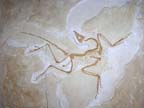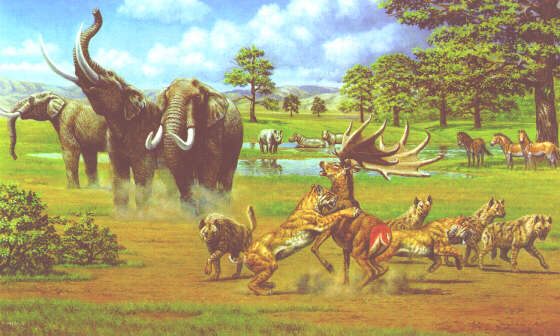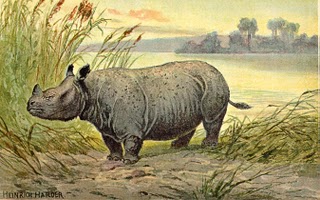 |
 |
 |
 |
 |
Produced
by the Population Genetics and Evolution class, Furman University |
||||
 |
 |
 |
 |
 |
Produced
by the Population Genetics and Evolution class, Furman University |
||||
 |
The
Neogene: Teleoceras |
 |
||
| Teleoceras
were a type of rhinoceros that inhabited what is now North America (Stephens
2000). They were first named by John Bell Hatcher in 1894, and several
complete fossils of these creatures have been found still intact. In fact,
they are often found with several other Teleoceras fossils around
them, meaning that these animals probably lived in herds (Emile 2008).
Teleoceras had large, barrel-like bodies and short, stubby legs
(Stephens 2000). They grew to be about thirteen feet long and probably
weighed a few tons (Robbins 2005). These animals also had a stubby horn
on their nose as well as sharp incisors, which were probably used for
defense. There is also some debate as to whether these animals were aquatic,
like the modern-day hippopotamus, or terrestrial like the rhinoceros.
Due to their body size and proportion, it seems as though these animals
would have been aquatic. However, Teleoceras do not have raised
eyes or nostrils like hippos do, which would make it hard for them to
remain in water. A few fossils have been found that contain a type of
fossilized grass which is only found on land, suggesting that these herbivores
often grazed on land. This evidence leads experts to believe that Teleoceras
were semi-aquatic, living at least partially in the water, but still going
on land occasionally (Emile 2008). Page by Lindsay Gerzel |
 |
| Teleoceras. Painting by Harder H. 2008. Pciture From: blogspot | |
|
Emile. 2008. Teleoceras, dachshund of the rhino world. The World We Don’t Live In. Accessed April 19, 2010. Robbins N. 2005. Teleoceras and the paleontology of rhinoceroses. Info Hub. Accessed April 19, 2010. Stephens T. 2000. Fossil teeth of extinct North American rhinos reveal an aquatic lifestyle similar to modern hippos. UC Santa Cruz. Accessed April 19, 2010. |